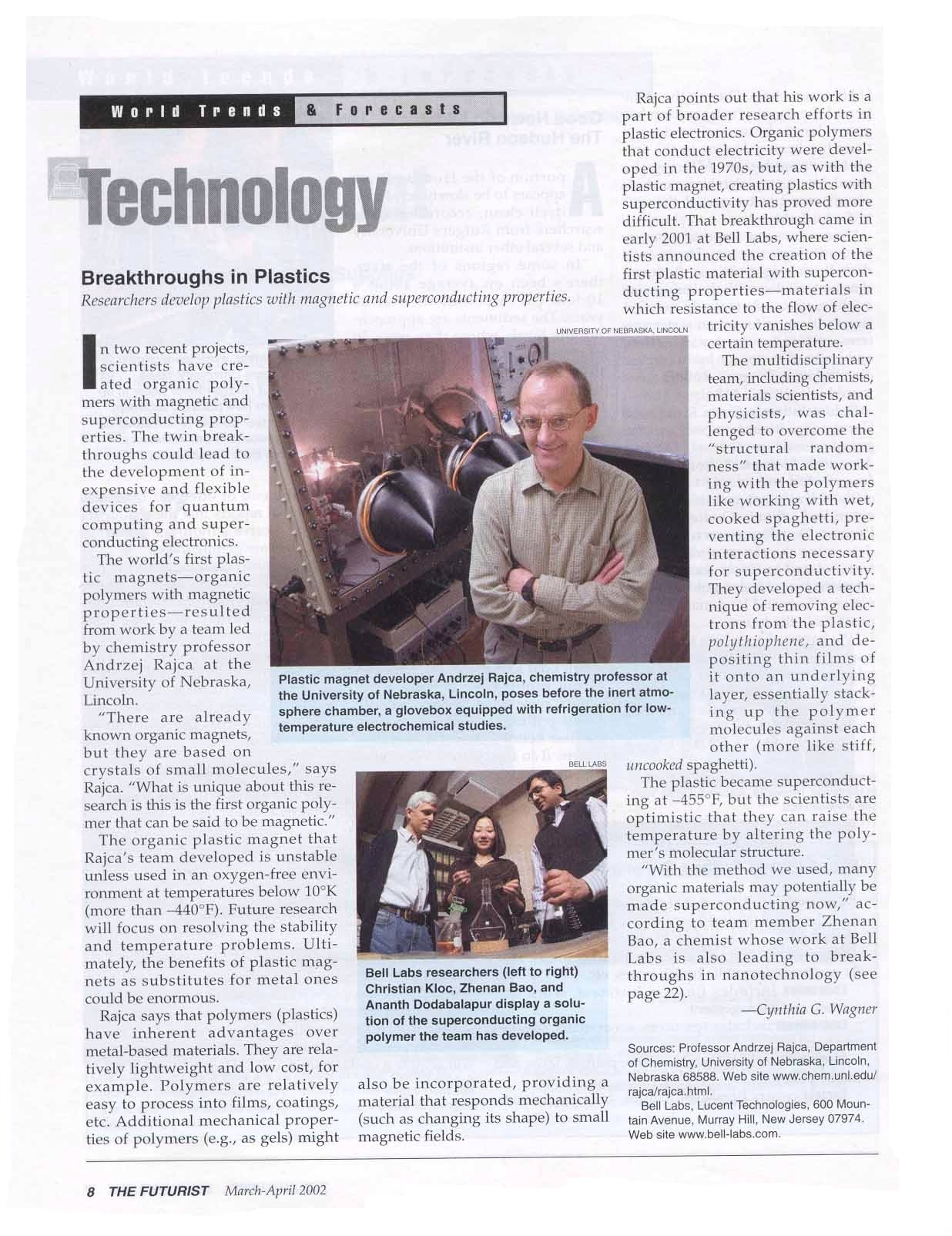 |
|
|
Breakthroughs in Plastics
Researchers develop plastics with magnetic and superconducting properties.
In two recent projects, scientists have created organic polymers with magnetic and superconducting properties. The twin breakthroughs could lead to the development of inexpensive and flexible devices for quantum computing and superconducting electronics.
The world's first plastic magnets--organic polymers with magnetic properties--resulted from work by a team led by chemistry professor Andrzej Rajca at the University of Nebraska, Lincoln.
"There are already known organic magnets, but they are based on crystals of small molecules," says Rajca. "What is unique about this research is this is the first organic polymer that can be said to be magnetic."
The organic plastic magnet that Rajca's team developed is unstable unless used in an oxygen-free environment at temperatures below 100K (more than 4400F). Future research will focus on resolving the stability and temperature problems. Ultimately, the benefits of plastic magnets as substitutes for metal ones could be enormous.
Rajca says that polymers (plastics) have inherent advantages over metal-based materials. They are relatively lightweight and low cost, for example. Polymers are relatively easy to process into films, coatings, etc. Additional mechanical properties of polymers (e.g., as gels) might also be incorporated, providing a material that responds mechanically (such as changing its shape) to small magnetic fields.
Rajca points out that his work is a part of broader research efforts in plastic electronics. Organic polymers that conduct electricity were developed in the 1970s, but, as with the plastic magnet, creating plastics with superconductivity has proved more difficult. That breakthrough came in early 2001 at Bell Labs, where scientists announced the creation of the first plastic material with superconducting properties--materials in which resistance to the flow of electricity vanishes below a certain temperature.
The multidisciplinary team, including chemists, materials scientists, and physicists, was challenged to overcome the "structural randomness" that made working with the polymers like working with wet, cooked spaghetti, preventing the electronic interactions necessary for superconductivity. They developed a technique of removing electrons from the plastic, polythiophene, and depositing thin films of it onto an underlying layer, essentially stacking up the polymer molecules against each other (more like stiff, uncooked spaghetti).
The plastic became superconducting at -4550F, but the scientists are optimistic that they can raise the temperature by altering the polymer's molecular structure.
"With the method we used, many organic materials may potentially be
made superconducting now," according to team member Zhenan Bao, a chemist
whose work at Bell Labs is also leading to breakthroughs in nanotechnology.
--Cynthia G. Wagner
Sources: Professor Andrzej Rajca, Department of Chemistry,
University of Nebraska, Lincoln, Nebraska 68588. Web site www.chem.unl.edu/rajca/rajca.html.
Bell Labs, Lucent Technologies, 600 Mountain Avenue, Murray Hill, New
Jersey 07974. Web site www.bell-labs.com.
Photo caption:
Plastic magnet developer Andrzej Rajca, chemistry professor at the
University of Nebraska, Lincoln, poses before the inert atmosphere chamber,
a glovebox equipped with refrigeration for low-temperature electrochemical
studies.
@credit:UNIVERSITY OF NEBRASKA, LINCOLN
|
Used with permission from the World Future Society, 7910 Woodmont Avenue, Suite 450, Bethesda, Maryland 20814. Telephone: 301/656-8274; Fax: 301/951-0394; http://www.wfs.org |
 |